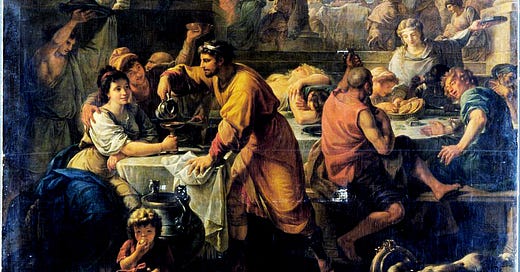New Year's resolution? Let's speak it afresh
The year ahead isn't really on the Church's radar, writes George Pitcher. But we can resolve to be better with the gospel for new generations.
The New Year’s resolution seems especially pointless this year. I doubt many of us will start a gym membership that we half-heartedly use only once – all that sweaty exchange of bodily fluids with strangers. And I suppose there may be not a few who resolve not to vote for charlatans if they get the chance in ‘22.
Otherwise, what to wish for? Not to catch covid (again). To work more from home (tick). Perhaps we should get out and walk more – it’s good for us, it’s safe and it’s free.
For those of us of faith, New Year’s Eve is a fairly silly, secular celebration in the middle of the 12-day feast of Christmas (seven swans a-swimming, since you ask), as we await the Epiphany on 6th January and the gift of the Christ Child to the Gentiles, with the coming of the Magi.
Great solemnity
It wasn’t always thus. New Year was observed with great solemnity in the pre-Christian era by pagans and by the Jews, who reckoned the year from the Feast of the New Moon at the end of September.
It was Julius Caesar who decreed that the Roman year started on 1st January, in his early piece of celebrity merchandising – the Julian Calendar. That was the day of the festival of Saturnalia, which the emperor moved from earlier in December, with sacrifices at the Temple of Saturn. The appointed King of Saturnalia was a precursor to the medieval Lord of Misrule, who presided at the Feast of Fools. (If only we had someone we could appoint Lord of Misrule to hold outrageous parties in our own time?)
Christians were not only forbidden by their Church to participate in these revelries, but even had special fasts and Masses, as recorded at the Second Council of Tours in 567, ad prohibendum ab idolis (“to keep them away from idols”).
Throughout medieval Europe, Christians reckoned the beginning of the year at different times. In England, it began with the Feast of the Annunciation on 25th March; in Germany with Christmas, and in France and the Low Countries with Easter.
The Gregorian Calendar from Pope Gregory XIII (get the T-shirt) brought New Year into line in 1582 as 1st January, though England demonstrated its usual exceptionalism by not adopting the date until 1752. Otherwise, New Year’s Day has never really been marked liturgically in the Church calendar, other than as the Feast of the Circumcision (“when eight days had been accomplished”) - and even that wasn’t recognised by Rome until the 11th century.
Pagan rioting
This reluctance to acknowledge New Year as a festival is attributed to a distaste for holding a liturgical feast during a day of pagan rioting, though the custom of holding a “watch-night” service on New Year’s Eve did develop (and it’s still popular with the Methodists, allegedly); 1st January became the Octave of the Nativity of Christ in 1960 in the Roman Catholic Church, also observed as the Solemnity of the Motherhood of the Blessed Virgin Mary. So that got the party really going.
It’s fair to assume that not that many in the household of faith would have noticed the year’s change. In the modern period, Christians have gathered on New Year’s Eve at something of a loose end, anywhere between mildly depressed in the Sixties at having to watch Moira Anderson and Andy Stewart execute reels on the telly (Jules Holland’s Hootenanny more recently) and mildly disapproving of pagan rituals such as the “first-footing” of a tall, dark stranger at the door with a lump of coal (what fun!).
Gruesome countdown
At least covid caution should have put paid to the truly gruesome countdown to midnight, crossed arms and held hands to warble Auld Lang Syne and slobbery kisses from strangers under bunches of mistletoe. It’s an ill wind, as they say.
The phoney Scottish element to these celebrations is barely rooted in any tradition at all. The Presbyterians disapproved of Hogmanay, but it survived as a public holiday, probably precisely because the national Church of Scotland didn’t recognise Christmas Day as a holiday until 1958. It was best, to be sure, that old acquaintance be forgotten.
So what is the Christian priest and her disciple to do on New Year’s Eve? To what tradition do we give ourselves – and, importantly, to what do we re-affirm ourselves for the year ahead?
One answer to that may arise from the Declaration of Assent that is made by deacons and priests, as well as laity, at their ordinations and licensings: To proclaim the faith “afresh in each generation.”
The Church isn’t very good at that, which is partly why more recent generations have gone missing from it. At the first covid lock-down in 2020, we locked-up our churches, arguably when they were needed most. We have not met people where we are, but vitally we have not met people where they are either.
The Church speaks in a mysterious code which younger generations can’t – and reasonably can’t be bothered – to understand. To acknowledge that properly, we must find the language to communicate that we’re better than this, that there is an alternative way, that our faith is disruptive and scandalous in a very good way.
And to speak that news afresh to each generation. In the way we live rather than the way we speak. That sounds like a New Year’s resolution to me.
George Pitcher is a visiting fellow at the LSE and an Anglican priest.




